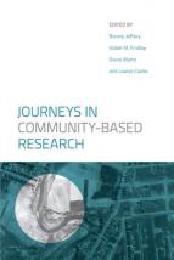Review
Journeys in Community-Based Research
- Bonnie Jeffery, Isobel M. Findlay, Diane Martz, and Louise Clarke, eds.
- University of Regina Press, 2016

To many people, pure academic research seems obscure, even irrelevant. Some organizations pointedly ridicule curiosity-based research, implying that only applied research – research undertaken to be put to use – is valuable. And then there is community-based research, a third form directed at positive action, social change, and advocacy, and also the subject of a recent book published by University of Regina Press. It might just change your mind about the significance of academic research.
Journeys in Community-Based Research examines ten years of community-based research in Saskatchewan. This research has been underwritten by two bodies – the Saskatchewan Population Health and Evaluation Research Unit (SPHERU) and the Community–University Institute for Social Research (CUISR) – that work with various partners to address community issues and create positive change. Readers may be familiar with some of the projects and their outcomes.
Community-based research (CBR) connects academic rigour with real community needs, producing valuable relationships among universities, policy-makers, non-governmental organizations, and social agencies. The goal is always to discover and deliver benefits for communities at large. As the volume editors explain, CBR relationships emphasize “the central values of power, voice, and control throughout all aspects of the partnership and process.” To realize the bigger goals of a project, partners need to be responsive, flexible, and willing to learn. The projects discussed in Journeys in Community-Based Research demonstrate how to set up partnerships and how to build trust and earn respect. The writers also reflect on what they have learned from specific projects and encourage others to adopt CBR to make lasting social change.
This is an important book for Saskatchewan readers. It discusses urgent local matters and examines how groups are working together to address communities’ most immediate needs. One idea that the book’s contributors take seriously is that successful solutions and directions for change must not be imposed on people. Decades of bad policies and failed initiatives have taught policy-makers this, yet it continues to happen again and again. When they adopt CBR, community agencies can direct researchers’ interests to questions that the members of a community want to address, such as the needs of women escaping domestic violence or the health outcomes of Aboriginal youth. Such an approach gives the community a leading role and encourages member empowerment. In view of the Truth and Reconciliation Commission’s 94 Calls to Action, community leadership and empowerment are vital to our social well-being and healing.
Journeys in Community-Based Research is not a book for everybody, but its potential reach is impressive. Most chapters are fairly accessible, if serious, and suit a broad readership. The book should be of interest not only to scholars and students, but also to community leaders, policy-makers, managers and frontline workers in helping agencies, and anyone interested in learning how on-the-ground research makes our communities stronger.
This review was originally published on www.skbooks.com .
